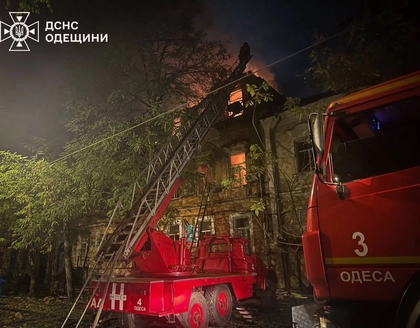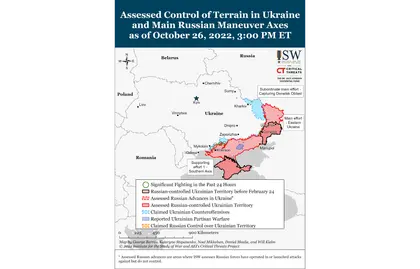Key Takeaways
- A Reuters investigation of Russian documents from Balakliya supports previous ISW assessments about the poor conditions of Russian forces.
- Putin stated that Ukraine has “lost its sovereignty” in an October 26 speech indicating that Russia likely retains its maximalist objectives in Ukraine and remains resistant to negotiations.
- Russian occupation officials in Kherson Oblast are attempting to mitigate the informational consequences of the Russian withdrawal from the west bank of the Dnipro River.
- Russian forces are attempting to fix Ukrainian forces on Ukraine’s northern border.
- Russian officials continued to acknowledge that Russian authorities are deporting Ukrainian children to Russia under the guise of adoption and vacation schemes.
- Yevgeny Prigozhin denied a previous ISW assessment that stated he confronted Putin and other siloviki factions regarding the progress of the war in Ukraine.
- Russian sources claimed that Ukrainian forces conducted counteroffensive operations west of Svatove.
- Russian forces continued to prepare defensive positions on the west and east banks of the Dnipro River in Kherson Oblast.
- Russian sources claimed that Ukrainian forces continued to conduct counteroffensive operations in northwest Kherson Oblast.
- Russian forces conducted ground attacks in Donetsk Oblast.
- The Russian military is reportedly attempting to recruit foreigners to support its war effort in Ukraine.
- Russian occupation officials in Kherson Oblast continued to relocate residents from the west bank of the Dnipro River.
A Reuters investigation of a document trove found in an abandoned Russian command post in Balakliya, Kharkiv Oblast, supports ISW’s longstanding assessments about the poor condition of Russian forces. ISW has long assessed that the conventional Russian military in Ukraine is severely degraded and has largely lost offensive capabilities since the summer of 2022, that Russian strategic commanders have been micromanaging operational commanders’ decisions on tactical matters, and that Russian morale is very low. Reuters’ investigation found that Russian units near Balakliya were severely understrength, with a combat battalion at 19.6-percent strength and a reserve unit at 23-percent strength.[1] The investigation found that poor morale, bad logistics, and overbearing commanders contributed to Russian forces’ poor performance.[2] The report found that the Russian Western Military District explicitly forbade a subordinate from withdrawing from an untenable position in the small village of Hrakove (which has an area of less than three square kilometers).[3] Ukrainian forces defeated Russian forces in Balakiya and routed Russian forces in eastern Kharkiv Oblast around September 8-10.[4]
JOIN US ON TELEGRAM
Follow our coverage of the war on the @Kyivpost_official.
Russian President Vladimir Putin’s rhetoric indicates that he is not interested in negotiating seriously with Ukraine and retains maximalist objectives for the war. Putin stated that Ukraine has “lost sovereignty” in a meeting with Commonwealth of Independent States (CIS) security officials on October 26.[5] Putin stated that the United States is using Ukraine as a “battering ram” against Russia, the Russian-Belarusian Union State, the Collective Security Treaty Organization, and the CIS. Russian State Duma Speaker Vyacheslav Volodin amplified this narrative, stating that “Ukraine has lost the ability to exist as a state,” “Ukraine is occupied by NATO,” and “[Ukraine] has become a colony of the US” on October 26.[6] This language is incompatible with negotiations on an equal basis for a ceasefire, let alone a resolution to the conflict that Russia began. It instead strongly suggests that the Kremlin still seeks a military victory in Ukraine and regime change in Kyiv that would affect the permanent reorientation of Ukraine away from the West and into Russia’s control. It also indicates that Putin’s aims transcend the territory he has claimed to have annexed, let alone the areas his forces actually control.

One Dead, Thousands Without Heating After Russian Strike on Odesa
Russian occupation officials in Kherson Oblast are attempting to mitigate the informational consequences of the chaos of the initial Russian withdrawals from the west bank of the Dnipro River. Kherson Oblast occupation head Vladimir Saldo stated on October 26 that it would be “practically impossible” to completely destroy the dam at the Kakhovka hydroelectric power plant (HPP) and that even the destruction of the dam locks at the HPP would only cause the water level of the Dnipro River to rise less than 2 meters.[7] Saldo’s statement directly contradicts his own prior statements and the warnings made by Commander of Russian Armed Forces in Ukraine Army General Sergey Surovikin on October 18 that Ukraine is planning to strike the Kakhovka HPP and cause flood damage along the Dnipro River.[8] Saldo’s apparent retraction of his own warnings may suggest that he seeks to quell anxiety accompanying the mass movement of civilians and Russian military and occupation elements across the Dnipro in order to preserve his own ability to rule. Saldo also issued assurances about the provision of basic utilities and financial services that he claimed will continue even as evacuations to the east bank are ongoing.[9] Saldo’s statements indicate that his administration is attempting to mitigate panic in the information space, likely in order to maintain control of the population of Kherson Oblast against the backdrop of ongoing evacuations.
Russian forces conducted an assault on Ternova, Kharkiv Oblast, likely to fix Ukrainian forces there and prevent them from reinforcing Ukrainian counteroffensive operations elsewhere. The Ukrainian General Staff reported on October 26 that Ukrainian forces repelled an attack on Ternova (40km northeast of Kharkiv city) which is well removed from areas encompassed by the eastern Ukrainian counteroffensive.[10] Russian forces likely do not intend to regain limited territory in border areas of Kharkiv Oblast but instead likely hope to keep Ukrainian forces in the area that otherwise could join counteroffensive operations. Russian forces are likely hoping for a similar outcome in northwestern Ukraine with their deployment of forces to the joint grouping of forces in Belarus and the messaging around it.
Russian officials continued to admit that Russia is deporting children to Russia under the guise of adoption and vacation schemes. Russian media reported on October 26 that the Russian Commissioner for Children’s Rights, Maria Lvova-Belova, adopted a Ukrainian child who was deported from Mariupol to Russia.[11] Lvova-Belova claimed that Russian officials have brought 31 children from Mariupol to Russia and that her office is working to “rehabilitate” Ukrainian children from active combat zones. As ISW has previously reported, the forced adoption of Ukrainian children into Russian families may constitute a violation of the Convention on the Prevention and Punishment of the Crime of Genocide.[12]
Russia is also continuing to use the excuse of recreational trips to deport Ukrainian children to Russia and Russian-occupied territory. Member of the Zaporizhia occupation administration Vladimir Rogov reported on October 26 that over 500 children from Enerhodar went on “vacation” in Yevpatoria, Crimea and Anapa, Krasnodar Krai this year alone.[13] Rogov claimed that the children received “new knowledge” as part of the “educational program.”[14] Russian-appointed governor of Sevastopol Mikhail Razvozhaev similarly claimed that children from occupied Kherson City and Enerhodar took part in “excursions” in Sevastopol.[15] These reports are consistent with ISW‘s previous observations that Russian officials have used the veneer of such recreation and rehabilitation programs to justify the deportation of Ukrainian children to Russian-controlled territory and areas of the Russian Federation.[16]
On October 26, Wagner Group financier Yevgeniy Prigozhin denied ISW’s report that Prigozhin confronted Putin and other siloviki factions in the Kremlin regarding the progress of the Russian war in Ukraine.[17] Prigozhin explicitly denied ISW’s October 25 assessment and falsely insinuated that ISW receives classified intelligence. ISW does not receive any classified material from any source, uses only publicly available information, and draws extensively on Russian, Ukrainian, and Western reporting and social media as well as commercially available satellite imagery and other geospatial data as the basis for these reports. ISW specifically does not receive information from Prigozhin’s deceased mother-in-law, as he (ironically) suggested.
Authors: George Barros, Karolina Hird, Riley Bailey, and Frederick W. Kagan
See the full report here
You can also highlight the text and press Ctrl + Enter






